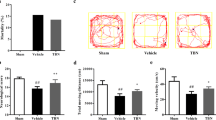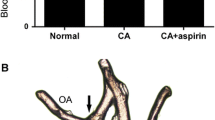Abstract
Purpose
Cerebral vasospasm is the common cause of poor outcome after aneurysmal subarachnoid hemorrhage (aSAH). Although many agents are experimentally and clinicaly used to protect or recover from vasospasm, an effective neurotherapeutic drug is still missing. Erythropoietin (EPO) is recently a promising candidate. The aim of this study is to investigate the dose-dependent effects of recombinant human EPO (rhEPO) on arterial wall in a rat femoral artery vasospasm model.
Methods
Thirty two animals were divided into four groups: vasospasm without any treatment (group A), vasospasm +250 IU/kg rhEPO group (group B), vasospasm +500 IU/kg rhEPO group (group C), and control group (group D). Rat femoral artery vasospasm model was used. For groups B and C, 7 days of 250 IU/kg and 500 IU/kg intraperitoneal rhEPO in 0.3 ml saline were administered respectively; and for groups A and D, 0.3 ml saline were administered intraperitoneally without any treatment. After 7 days, histological and morphometric analyses were carried out.
Results
Vasospasm alone group demonstrated the highest vessel wall thicknesses, comparing to other groups (p < 0.001). While for groups B and C, vessel wall thickness values were significantly higher than the control group (p < 0.001), between these two groups, there was no significant difference achieved (p > 0.05).
Conclusion
In our study, there was no significant difference between the two rhEPO treatment groups, but rhEPO treatment was shown to be histologically and morphometrically effective in vasospasm. However, if dosage of EPO treatment is augmented, successful results may be achieved.


Similar content being viewed by others
References
Akisu M, Tuzun S, Arslanoglu S, Yalaz M, Kultursay N (2001) Effect of recombinant human erythropoietin administration on lipid peroxidation and antioxidant enzyme(s) activities in preterm infants. Acta Med Okayama 55:357–362
Ayer RE, Zhang JH (2008) Oxidative stress in subarachnoid haemorrhage: significance in acute brain injury and vasospasm. Acta Neurochir Suppl 104:33–41
Banerjee D, Rodriguez M, Nag M, Adamson JW (2000) Exposure of endothelial cells to recombinant human erythropoietin induces nitric oxide synthase activity. Kidney Int 57:1895–1904
Beleslin-Cokic BB, Cokic VP, Yu X, Weksler BB, Schechter AN, Noguchi CT (2004) Erythropoietin and hypoxia stimulate erythropoietin receptor and nitric oxide production by endothelial cells. Blood 104:2073–2080
Bernaudin M, Marti HH, Roussel S, Divoux D, Nouvelot A, MacKenzie ET, Petit E (1999) A potential role for erythropoietin in focal permanent cerebral ischemia in mice. J Cereb Blood Flow Metab 19:643–651
Brines ML, Ghezzi P, Kenan S, Agnello D, de Laner Olle NC, Cerami C et al (2000) Erytropoetin crosses the blood brain barrier to protect against experimental brain injury. Proc Natl Acad Sci USA 97(10):526–531
Cheng G, Wei L, Zhi-Dan S, Shi-Guang Z, Xiang-Zhen L (2009) Atorvastatin ameliorates cerebral vasospasm and early brain injury after subarachnoid hemorrhage and inhibits caspase-dependent apoptosis pathway. BMC Neurosci 21(10):7
Coleman TR, Westenfelder C, Togel FE, Yang Y, Hu Z, Swenson L et al (2006) Cytoprotective doses of erythropoietin or carbamylated erythropoietin have markedly different procoagulant and vasoactive activities. Proc Natl Acad Sci USA 103:5965–5970
Dorhout Mees SM, Rinkel GJ, Feigin VL, Algra A, van den Bergh WM, Vermeulen M, van Gijn J (2007) Calcium antagonists for aneurysmal subarachnoid haemorrhage. Cochrane Database Syst Rev Jul 18(3):CD000277. Review
d’Uscio LV, Smith LA, Santhanam AV, Richardson D, Nath KA, Katusic ZS (2007) Essential role of endothelial nitric oxide synthase in vascular effects of erythropoietin. Hypertension 49:1142–1148
Grasso G, Buemi M, Corica F, Calapani G, Salpietro FM, Casuscelli T et al (2000) In vivo evidence that erythtropoetin has a neuro-protective effect during subarachnoid hemorrhage. Eur J Pharmacol 392:31–34
Ito H, Fukunaga M, Suzuki H, Miyakoda G, Ishikawa M, Yabuuchi Y, Taki W (2008) Effect of cilostazol on delayed cerebral vasospasm after subarachnoid hemorrhage in rats: evaluation using black blood magnetic resonance imaging. Neurobiol Dis 32:157–161
Kern M, Lam MM, Knuckey NW, Lind CR (2009) Statins may not protect against vasospasm in subarachnoid haemorrhage. J Clin Neurosci 16:527–530, Epub 2009
Kiriş T, Karasu A, Yavuz C, Erdem T, Unal F, Hepgül K, Baloğlu H (1999) Reversal of cerebral vasospasm by the nitric oxide donor SNAP in an experimental model of subarachnoid haemorrhage. Acta Neurochir (Wien) 141:1323–1328, discussion 1328–1329
Kramer AH, Zygun DA, Bleck TP, Dumont AS, Kassell NF, Nathan B (2009) Relationship between hemoglobin concentrations and outcomes across subgroups of patients with aneurysmal subarachnoid hemorrhage. Neurocrit Care 10:157–165
Leist M, Ghezzi P, Grasso G, Bianchi R, Villa P, Fratelli M et al (2005) Derivatives of erythropoietin that are tissue protective but not erythropoietic. Science 305:239–242
Mayberg MR, Okada T, Bark DH (1990) Morphologic changes in cerebral arteries after subarachnoid hemorrhage. Neurosurg Clin N Am 1:417–432
Mayberg MR, Okada T, Bark DH (1990) The significance of morphological changes in cerebral arteries after subarachnoid hemorrhage. J Neurosurg 72:626–633
Mori K, Miyazaki M, Hara Y, Aiko Y, Yamamoto T, Nakao Y (2009) Novel vasodilatory effect of intracisternal injection of magnesium sulfate solution on spastic cerebral arteries in the canine two-hemorrhage model of subarachnoid hemorrhage. J Neurosurg 110:73–78
Mori K, Miyazaki M, Iwata J, Yamamoto T, Nakao Y (2008) Intracisternal infusion of magnesium sulfate solution improved reduced cerebral blood flow induced by experimental subarachnoid hemorrhage in the rat. Neurosurg Rev 31:197–203, discussion 203
Murphy AM, Xenocostas A, Pakkiri P, Lee TY (2008) Hemodynamic effects of recombinanthuman erythropoietin on the central nervous system after subarachnoid hemorrhage: reduction of microcirculatory impairment and functional deficits in a rabbit model. J Neurosurg 109:1155–1164
Okada T, Harada T, Bark DH, Mayberg MR (1990) A rat femoral artery model for vasospasm. Neurosurgery 27:349–356
Pluta RM (2008) Dysfunction of nitric oxide synthases as a cause and therapeutic target in delayed cerebral vasospasm after SAH. Acta Neurochir Suppl 104:139–147, Review
Rinkel GJ, Feigin VL, Algra A, Vermeulen M, van Gijn J (2002) Calcium antagonists for aneurysmal subarachnoid haemorrhage. Cochrane Database Syst Rev 4:CD000277
Ruschitzka FT, Wenger RH, Stallmach T, Quaschning T, de Wit C et al (2000) Nitric oxide prevents cardiovascular disease and determines survival in polyglobulic mice overexpressing erythropoietin. Proc Natl Acad Sci USA 97:609–613
Sakanaka M, Wen TC, Matsuda S, Masuda S, Morishita E, Nagao M, Sasaki R (1998) In vivo evidence that erythropoietin protects neurons from ischemic damage. Proc Natl Acad Sci USA 95:4635–4640
Santhanam AV, Katusic ZS (2006) Erythropoietin and cerebral vascular protection:role of nitric oxide. Acta Pharmacol Sin 27:1389–1394, Review
Santhanam AV, Smith LA, Akiyama M, Rosales AG, Bailey KR, Katusic ZS (2005) Role of endothelial NO synthase phosphorylation in cerebrovascular protective effect of recombinant erythropoietin during subarachnoid hemorrhage-induced cerebral vasospasm. Stroke 36:2731–2737
Schubert GA, Schilling L, Thomè C (2008) Clazosentan, an endothelin receptor antagonist, prevents early hypoperfusion during the acute phase of massive experimental subarachnoid hemorrhage: a laser Doppler flowmetry study in rats. J Neurosurg 109:1134–1140
Springborg JB, Møller C, Gideon P, Jørgensen OS, Juhler M, Olsen NV (2007) Erythropoietin in patients with aneurysmal subarachnoid haemorrhage: a double blind randomised clinical trial. Acta Neurochir (Wien) 149:1089–1101, discussion 1101
Springborg JB, Sonne B, Frederiksen HJ, Foldager N, Poulsgaard L, Klausen T, Jorgensen OS, Olsen NV (2003) Erythropoietin in the cerebrospinal fluid of patients with aneurysmal subarachnoid haemorrhage originates from the brain. Brain Res 984:143–148
Squadrito F, Altavilla D, Squadrito G, Campo GM, Arlotta M, Quartarone C, Saitta A, Caputi AP (1999) Recombinant human erythropoietin inhibits iNOS activity and reverts vascular dysfunction in splanchnic artery occlusion shock. Br J Pharmacol 127:482–488
Sugawara T, Ayer R, Zhang JH (2008) Role of statins in cerebral vasospasm. Acta Neurochir Suppl 104:287–290
Suzuki Y, Shibuya M, Satoh S, Sugiyama H, Seto M, Takakura K (2008) Safety and efficacy of fasudil monotherapy and fasudil-ozagrel combination therapy in patients with subarachnoid hemorrhage: sub-analysis of the post-marketing surveillance study. Neurol Med Chir (Tokyo) 48:241–247, discussion 247–248
Tseng MY, Hutchinson PJ, Richards HK, Czosnyka M, Pickard JD, Erber WN, Brown S, Kirkpatrick PJ (2009) Acute systemic erythropoietin therapy to reduce delayed ischemic deficits following aneurysmal subarachnoid hemorrhage: a Phase II randomized, double-blind, placebo-controlled trial. J Neurosurg 111:171–180
Villa P, van Beek J, Larsen AK, Gerwien J, Christensen S, Cerami A, Brines M, Leist M, Ghezzi P, Torup L (2007) Reduced functional deficits, neuroinflammation, and secondary tissue damage after treatment of stroke by nonerythropoietic erythropoietin derivatives. J Cereb Blood Flow Metab 27:552–563
Wang H, Gao J, Lassiter TF, McDonagh DL, Sheng H, Warner DS, Lynch JR, Laskowitz DT (2006) Levetiracetam is neuroprotective in murine models of closed head injury and subarachnoid hemorrhage. Neurocrit Care 5:71–78
Conflicts of Interest
None
Author information
Authors and Affiliations
Corresponding author
Rights and permissions
About this article
Cite this article
Ulusal, I., Tari, R., Ozturk, G. et al. Dose-dependent ultrastructural and morphometric alterations after erythropoietin treatment in rat femoral artery vasospasm model. Acta Neurochir 152, 2161–2166 (2010). https://doi.org/10.1007/s00701-010-0775-6
Received:
Accepted:
Published:
Issue Date:
DOI: https://doi.org/10.1007/s00701-010-0775-6




